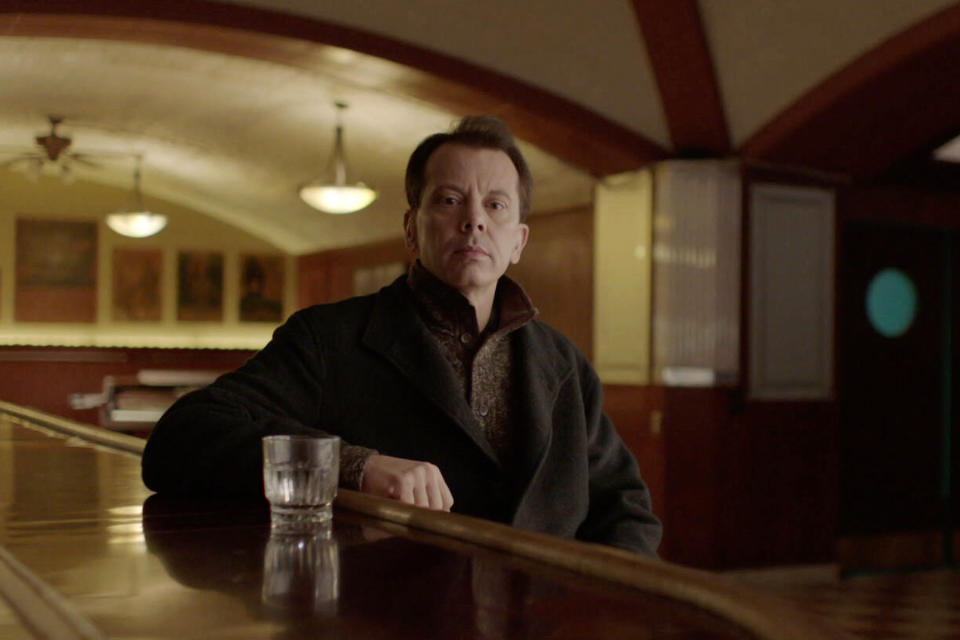His Life Was Like a Hollywood Heist Movie. Now, He’s Telling His Story
- Oops!Something went wrong.Please try again later.

On a June day in 1998, at the height of the summer tourist season, Gerald Daniel Blanchard entered Schönbrunn Palace in Vienna and deftly removed a diamond-and-pearl-encrusted pin that had once belonged to Empress Elisabeth of Austria from its display case, leaving a replica from the museum’s gift shop in its place.
Nine years later, in May 2007, police in Winnipeg, Canada discovered the priceless piece tucked inside a wall of Blanchard’s grandmother’s home, while raiding the house for stolen cash and goods. The recovery of the royal jewels dominated the headlines — but their theft was one of many for Blanchard, from shoplifting as a teenager in the 1980s, to robbing and defrauding banks well into adulthood.
More from Rolling Stone
Andrew Tate Compares Himself to Titanic Victims In Nauseating Tucker Carlson Interview
Lady Gaga Won't Have to Pay Woman Who Helped Steal Her Dogs a $500K Reward, Judge Says
Former Manson Family Member Leslie Van Houten Released From Prison
Blanchard started documenting his crimes on video in high school, accumulating hundreds of hours of footage, and obsessively keeping records from each job. But despite all the evidence, he has ensured that some key details about how he pulled off some of these stunts remain a mystery. “I want to leave it up to [people’s] imagination,” he says. “It makes the story more interesting.”
Landon Van Soest, the director of The Jewel Thief, a documentary about Blanchard premiering on Hulu on July 13th, agrees; and after being “obsessed with this story for over a decade,” hopes audiences will be equally intrigued.
“There has been this mythology constructed around him being a larger-than-life criminal mastermind figure — probably invented or at least perpetuated by himself,” Van Soest tells Rolling Stone. “He’s clearly very proud of what he was able to accomplish.”
But Blanchard isn’t solely responsible for this status. Since his January 2007 arrest, the police officers and prosecutors who eventually put him behind bars have repeatedly referred to the Canadian citizen as “cunning and creative,” “uncommonly gifted,” and “a James Bond kind of guy on the other side of the fence.” Although Blanchard was ultimately caught and served prison time for his crimes, the two decades he spent living out the plot of a Hollywood heist film offer a glimpse into a life few people experience — and one that leaves more questions than answers.
UNTIL THE AGE OF EIGHT, Blanchard had a comfortable childhood in Winnipeg. “I grew up wealthy,” Blanchard tells Rolling Stone. But when his parents split up, he and his mother relocated to Omaha, Nebraska, where he says they were “really poor.” According to Blanchard, he spent four and a half years at Boys Town, the residential school for troubled youths in Omaha’s inner-city, made famous in the 1938 film of the same name starring Spencer Tracy and Mickey Rooney. In the movie, Tracy played Father Edward J. Flanagan: the Irish priest who founded the institution — originally for orphaned boys — in 1917. At 15, Blanchard says he moved over to Father Flanagan High School.
“[The students] in that school were all troubled,” Blanchard recalls. “I wasn’t a troubled youth at that time, so when I was put into this pool of students, I really branched out and [learned about] different opportunities to make money.”
Wasting no time, Blanchard — an unassuming, wiry, bespectacled teen — began stealing from electronics, furniture, and department stores, including completely clearing out a local RadioShack with some friends on Easter Sunday 1987. “The store was closed,” he says. “I shut off the alarm system, and we took the whole store and put in a U-Haul.” This ultimately led to his arrest for grand theft at age 15, though he was released on probation after serving three months.
“Race played a big part,” Blanchard explains in the documentary. “I was a white kid that went to school, and in the court system, when they see this little kid, ‘Oh, he stole some stuff from RadioShack, let’s give him probation versus sending him off to juvenile school.’ It helped a lot.”
While the impact of Blanchard’s race isn’t discussed at length in the film, Van Soest says being a “scrawny, nerdy-looking white kid” did work to Blanhard’s advantage. “So many of his peers who were not doing the types of things he was doing to the same degree, and not being nearly as braggadocious about it, faced far more severe consequences,” he explains. “I think that’s just a reality of our penal system.”
Meanwhile, being on probation didn’t deter Blanchard from picking up where he left off; in fact, he says it expanded his customer base. “My probation officer asked [me to get him] some car stereos, answering machines, and cordless phones from RadioShack,” he tells Rolling Stone. “So I started selling stuff to probation officers.”
At this point, Blanchard was pulling in between $4,000 and $8,000 a week fabricating receipts and pocketing refunds from returning stolen merchandise, according to his own archival footage from the late 1980s featured in the documentary. By the time he was 16, he had enough money to buy a house.
“While it might have started as some kind of a response to poverty and a meek upbringing, it outpaced that very quickly,” Van Soest tells Rolling Stone. “He was clearly not doing these crimes for the money after his very early days, if at all.”
By the time Blanchard was 21, his rap sheet included multi-city theft sprees, breaking into a police impound lot, and escaping from police custody. Then, in April 1993, he was arrested for crimes related to an incident in which he helped set a car on fire, stole a police badge, gun, radio, and other equipment, and escaped from police custody twice in a 24-hour period — once in a stolen police cruiser. Five months later, an Iowa court sentenced Blanchard to seven years in prison for second-degree theft and second-degree arson charges. He served four years of his sentence, which concluded with his deportation back to Canada in 1997.
Blanchard settled in Winnipeg, and immediately fell back into his old ways. But before long he says that he came to a realization: “Why was I doing these small returns for small money, when I could actually just take the cash from the bank?”
Though he organized and planned the robberies, he rarely acted alone. “Everyone has their special skill,” he says. “Mine was the security aspect. I could have [robbed] ATMs by myself [and made] half a million dollars, but instead, I brought in a couple other people that were good at different things, [which] made the team stronger.”
Between robberies, Blanchard enjoyed a jet-setting lifestyle, visiting exclusive hotspots around the world using one of his many aliases (and the corresponding fraudulent passport), often in disguise. Armed with money and confidence, he gained access to events like the Stanley Cup Final, and hobnobbed with professional athletes. He sailed on yachts, drove Ferraris, went scuba diving, and took helicopter rides during his travels around the world.
“I like having things you’re not supposed to have, ’cause it makes me feel special,” Blanchard says in a recording of a wiretapped conversation featured in the documentary.
More than anything else, Blanchard sought out the rush and excitement that came from successfully pulling off a crime.
“I don’t do drugs, I don’t smoke,” he tells Rolling Stone. “My addiction was thrill-seeking.”

WHEN BLANCHARD VISITED Vienna in June 1998, he was in the midst of an extended tour of Europe with his then-wife and her wealthy father, at the beginning of what turned out to be a brief marriage. His former father-in-law secured VIP-access to a special exhibit at Schönbrunn Palace featuring items that once belonged to Empress Elisabeth of Austria, commemorating the 100th anniversary of her assassination.
Also known as “Sisi,” Empress Elisabeth is one of the best-known and most popular members of the Hapsburg dynasty. In the most famous portrait of the monarch, 27 diamond and pearl celestially-shaped pins, known as the “Sisi Stars,” adorn her nearly floor-length chestnut hair. Though iconic in Austria, when Blanchard saw the one on display at the museum, it held no special meaning or significance for him. “I just thought it was pretty,” he explains.
In fact, it was one of five items in the museum that caught his eye. “My original plan was to take a crown,” Blanchard says, noting that he opted for the Sisi Star because it turned out to be the easiest to access.
“I thought the museum would know that the diamond was taken right away,” Blanchard explains. “Like three weeks later, I saw on Sky News that they found out that the diamond had been switched, and I had it hidden in my scuba gear.”
By 2010, the mythology surrounding the theft of the Sisi Star expanded to include one of the most captivating — and controversial — details yet: that Blanchard reportedly gained access to the museum D.B. Cooper-style, jumping out of a small airplane and parachuting onto the grounds. “[The parachute story] is impossible to verify,” says Van Soest, who used court records and firsthand accounts to fact-check the details of Blanchard’s crimes. “I’ve heard that he chartered a plane; in another story it’s a helicopter. It’s like a game of telephone.”
Blanchard’s version of the events has shifted repeatedly, something the consummate showman says is intentional. “I’ll put it like this: when you get sentenced before a judge, you can’t be like, ‘Hey, I’m the mastermind for all of this’ — you have to deflect some of the attention elsewhere,” he explains. “Saying I parachuted onto the castle is much more serious than saying I didn’t do it.”

BLANCHARD FIRST MADE IT onto the Winnipeg police department’s radar when they noticed a link between his 2004 robbery of a CIBC bank and a string of similar crimes in Ontario, Alberta, and British Columbia. Impressed with his sophisticated methods, the operation grew to a team of 20 full-time investigators dedicated to the case.
In January 2007, Blanchard and six of his associates were arrested on charges of fraud, theft, conspiracy, trafficking, and participating in a criminal organization. That June, Winnipeg police obtained a warrant to search his grandmother’s house, where they found the Sisi Star in the wall, seized computers, a credit card manufacturing machine, and 120 surveillance tapes, and arrested Blanchard for a second time. In October 2007, he agreed to plead guilty to 16 of the 54 charges he faced, including possession of the royal jewel, and thefts from multiple financial institutions. The following month, a Manitoba court sentenced him to eight years in prison, and to pay $500,000 in restitution to the CIBC bank he robbed in 2004.
“I was looking at 160 years for all my charges,” he says. “I forfeited all my assets, all my money, gave the [Sisi Star] back, and ended up with eight years. I was out after 18 months.”
Several years and countless advancements in security technology later, Blanchard remains confident in his bank-robbing skills. “It’s tempting, but my feeling is the police know my MO, so if I were to do anything, I would have to change it up,” he says. “I still have five or six different MOs I could easily do to off throw the banks. But I live this comfortable life now, and don’t need to worry about committing crimes.”
Though Blanchard insists his heisting days are behind him, his propensity for thrill-seeking, like other types of addictions, lingers. “You can never say never,” he says. “It’s a spur of the moment decision, [and] things are always there.”
Best of Rolling Stone

